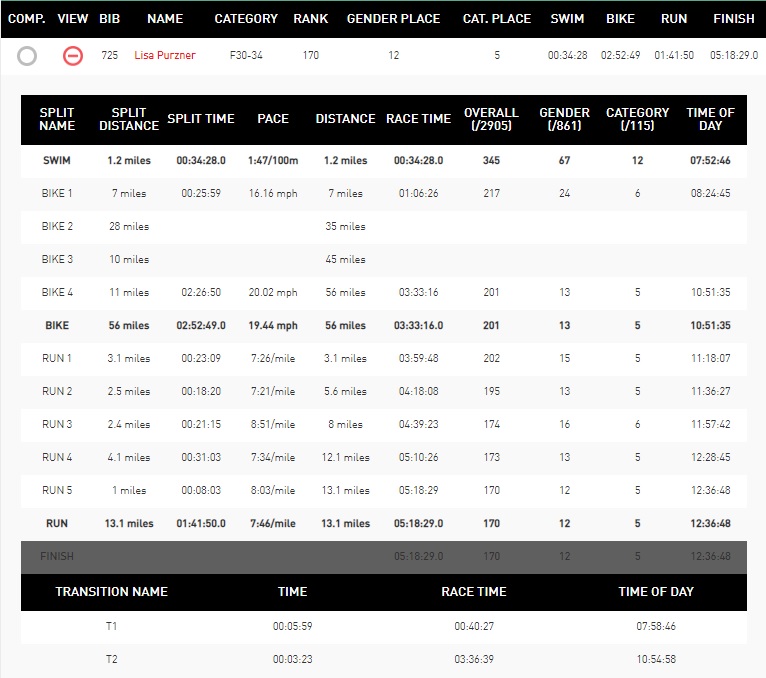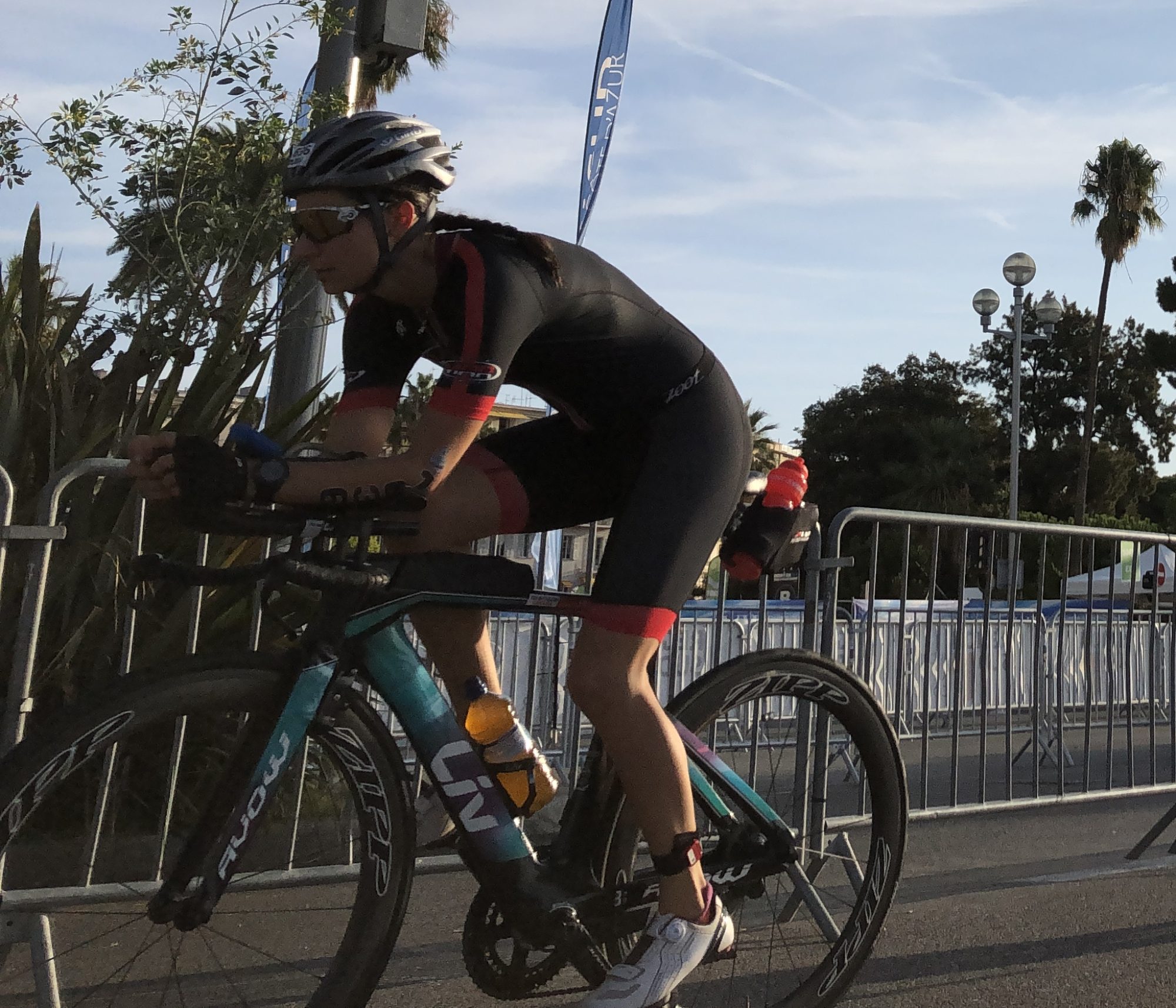Why Lake Placid?
Lake Placid, New York, is a rather special place. I was first introduced to the Adirondacks during a week-long combined NYC/hiking trip with my physio friends back in 2012. After spending three days hiking up and down the northeast Appalachian mountain range, we drove up Route 73 from Keene Valley into Lake Placid for well-earned pizza and beer. I was mesmerized by the winding road along the cascading rivers and picturesque lakes, and I vowed to return one day to further explore the area.
Fast forward 6 years… My husband and I have spent three out of our past four annual June training holidays in Lake Placid because we love the place so much. Apparently we’re not alone. Lake Placid is the only American town that has hosted the Winter Olympic Games twice – in 1932 and 1980. It is also the longest-running full Ironman in North America, aside from the Ironman World Championship. Once you’ve arrived in this warm, welcoming, all-American town, it’s hard to not fall in love. A stroll down Main Street tempts you with local craft brew pubs, hipster coffee shops and quaint shops selling bear-themed souvenirs. Mirror Lake is a notoriously calm, motorboat-free lake that has a 2 km loop of anchored steel cable that sits 3 to 4 feet below the water surface. The cable basically eliminates the need to sight, except to prevent collisions with your fellow swimmers – of which there are plenty on warm, summer days.
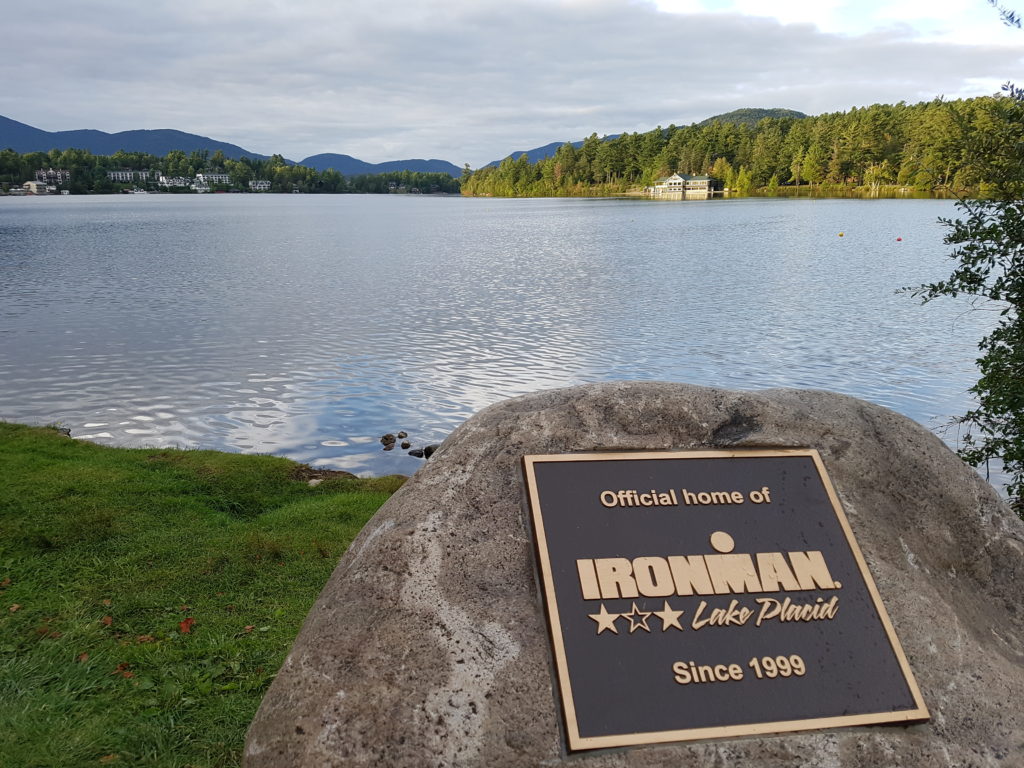
Local drivers are very considerate of giving cyclists plenty of space on the mostly wide shoulders along the heavily cycled Ironman bike loop that connects Lake Placid, Keene, Jay and Wilmington. Over the past couple of years, there have been notable road improvements along the bike course, including re-paving the steep 5-mile descent on Route 73 into Keene, where cyclists can easily reach speeds beyond 70 km/h and I personally no longer feel comfortable staying in my aerobars. The Ironman run course is basically an out-and-back run past the Olympic ski jumping complex, down Riverside Drive, with a one-mile out-and-back jaunt along Mirror Lake Drive before entering the historic Olympic speed skating oval and classic Ironman finish chute. I clearly love this town and when I found out Lake Placid was hosting the 70.3 a second time around (my best friend got married on the LP 70.3 inauguration weekend in 2017), I signed up without any hesitation.
Race Preparation
This was my first race since I had started working with a coach, Cindy Lewis-Caballero, in early August. Throughout August, I was training 13 to 15 hours per week, which included 3 open water swims, 3 rides, 4 runs (2 of which were off the bike) and one 30-minute strength session in a typical week. On August 25th, I misread my workout plan and accidentally rode the entire 3-hour bike ride at Half Ironman pace, rather than the prescribed 90 minutes of it. Over the next two weeks leading up to the race, I continued to experience a dull, achy discomfort in my left hamstring while running uphill or beyond zone 2. During taper week, Cindy drastically reduced my training volume and intensity, down to 5 hours with only one easy run, so that I could rest my hamstring. In spite of this poorly timed hammy injury, I remained optimistic. I was eager to compete at my first international race and perform my absolute best. My two goals were: 1) to finish in under 5½ hours and 2) to finish on the podium within my age group. As much as I would love to race a sub 5 hour half Ironman, I was all too familiar with the challenging bike course and the weather report was calling for unseasonably cold temperatures, similarly to the race in 2017.
On Friday, September 7th, Rod and I left Elliot Lake at 7:30 am and we shared the scenic 10-hour drive along the north border of Algonquin Park through Ottawa Valley to Lake Placid. I had plenty of time to process the race plan Cindy had emailed me, which was essentially a 10-minute swim warm-up, an evenly paced swim with increased kick towards the end, power output guidelines for the bike and a hold-on-as-long-as-you-can suggested pace for the run. After a few brief road stops and several snacks from my massive lunch bag, we checked into our Airbnb moments before our friends, Lauren, who was also racing, and her husband, Alex, arrived from Toronto.
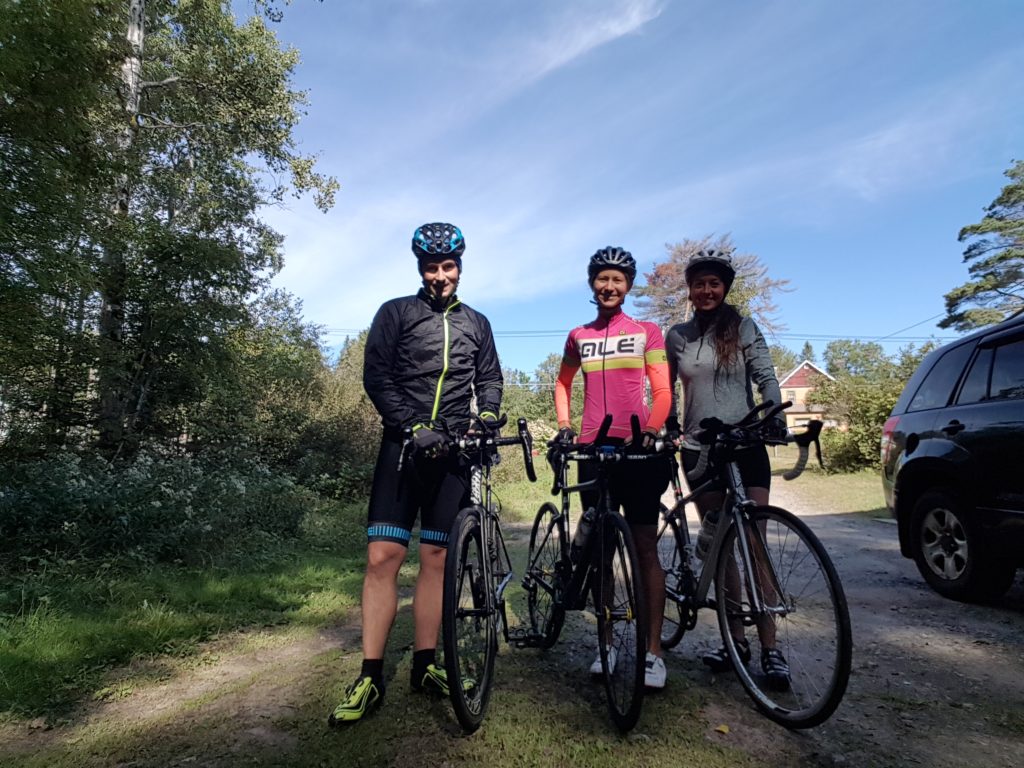
On Saturday morning, Lauren, Rod and I headed out for an easy 40-minute bike ride down River Road with a few short intervals at race pace intensity. We leisurely rode the one mile on our bikes to Athlete Check-In at the Conference Center and met a super friendly guy named Adam from Chattanooga, Tennessee, who was competing in his second-ever triathlon and his first Ironman 70.3. We breezed through the check-in process and racked our bikes in the Olympic Oval aka transition. Unlike Muskoka 70.3, there was no mad dash to arrive as early as possible in transition because our bikes were racked according to our bib numbers already labelled on the racks. Rod, Lauren and I lingered in transition to attend the pre-race briefing, which was essentially a stern cold weather warning. The announcer stressed that the forecast was calling for very cold temperatures for the morning, and that we should layer up with gloves, arm sleeves, jackets and knee warmers to prevent hypothermia. Ironman had also decided to set up warming tents at the swim start and in the transition zone, as well as large change tents for athletes to remove their wet clothing before the bike (typically only available for use during the full Ironman), and offer warm chicken broth on the bike course after the descent into Keene.
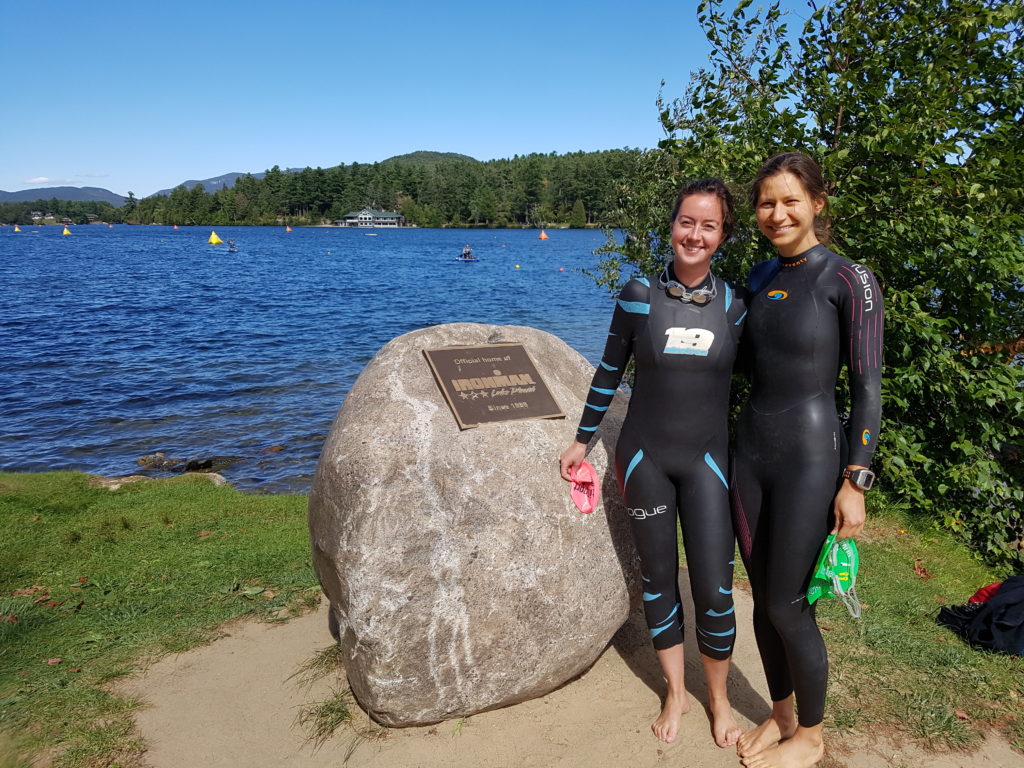
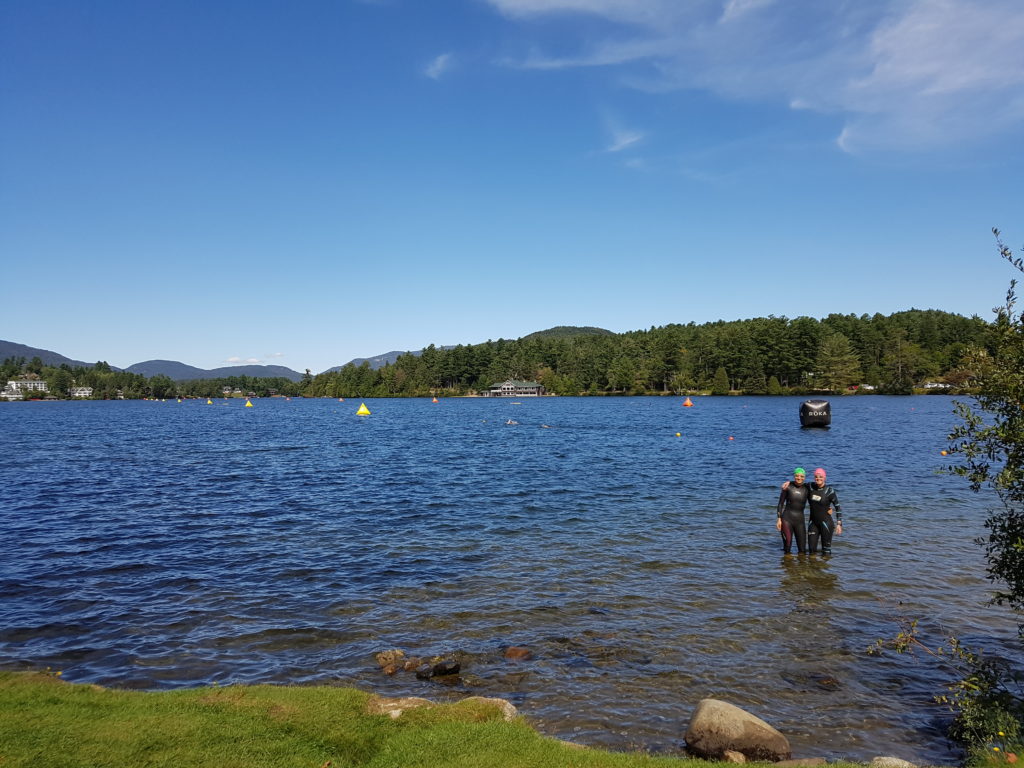
Ironman Village was insane. I have never seen so much Ironman paraphernalia, from baby onesies and taco cycling jerseys to aprons and cookie cut-outs. Lauren and I purchased the same pair of Roka goggles and made our way over the Mirror Lake for a shakeout swim. The cliché saying, nothing new on race day, really rang true, as my new goggles incessantly leaked so aggressively that my contact lenses started to shift. I swam back to shore and swapped for my new pair of Speedo Vanquisher goggles. The lake was a lovely temperature, a few degrees warmer than what I had been training in Elliot Lake all summer long, but I appreciated having a wetsuit as the air temperature was a brisk 16°C. I swam moderately easy for 15 minutes and managed to sneak in a few drills from previous swim workouts this summer. Upon Lauren and I exiting the water, Rod declared that he was getting pizza at Balzac’s. Lauren and I realized we were also hungry and grabbed a veggie slice before starting our mad dash to find Lauren a pair of arm warmers.
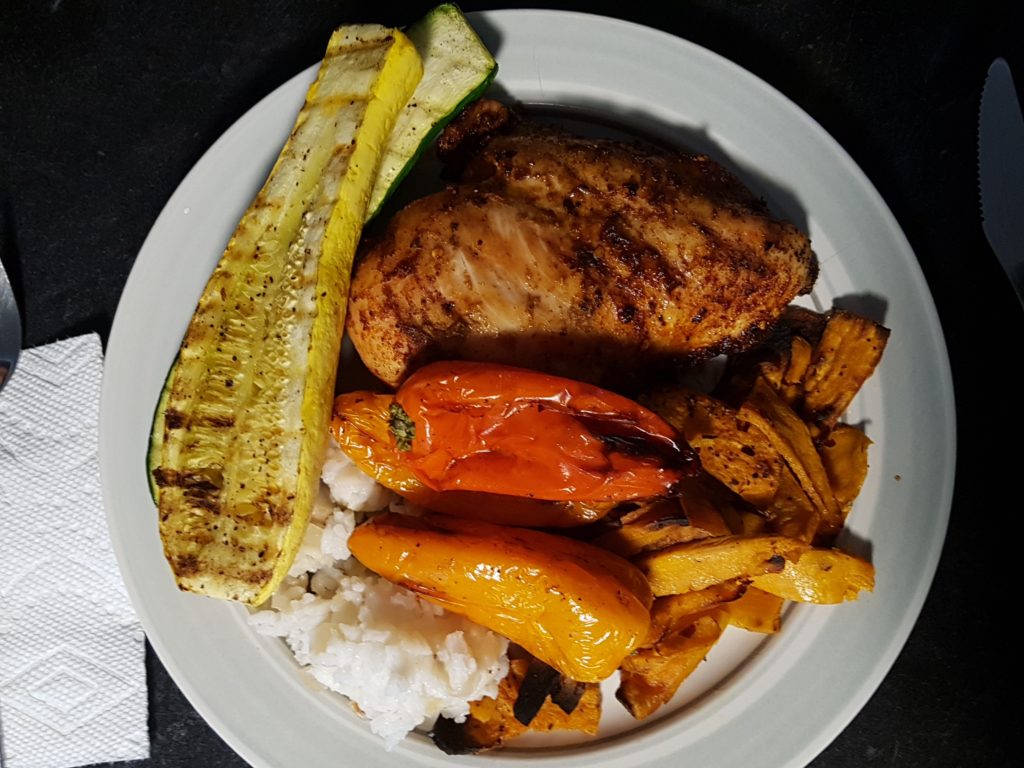
Our 6:30 pm pre-race dinner consisted of roasted sweet potatoes, white rice with onions and mushrooms, grilled zucchini, peppers and chicken breasts, with a small brownie and ice cream for dessert. We spread all our gear and race fuel out on the living room floor and, probably like all other 2000 triathletes in Lake Placid, debated how many layers to wear on the bike and whether to fully change out of our wet clothes after the swim. We were in bed at 10 pm, slept for at least a few hours despite the inevitable pre-race tossing and turning, and I was up promptly at 4:15 am. Although I was still full from the previous night’s high-carb dinner, I made Rod and I our pre-race meal of French toast and fruit. Alex kindly dropped us off in town at 5:30 and we sauntered up Main Street in the dark with a bunch of other wide-eyed, bundled-up triathletes – I’m sure the scene was similar to a zombie apocalypse. After body marking, we entered transition and I organized all my gear, including thermal sleeves, my new pink & purple Alé bike jersey, pink cycling jacket and a Buff. I was still undecided as to what I was going to wear during the ride and agreed to make a game-time decision in T1.
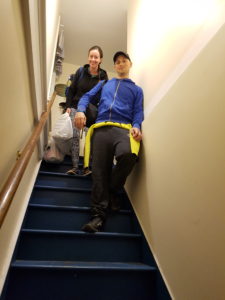
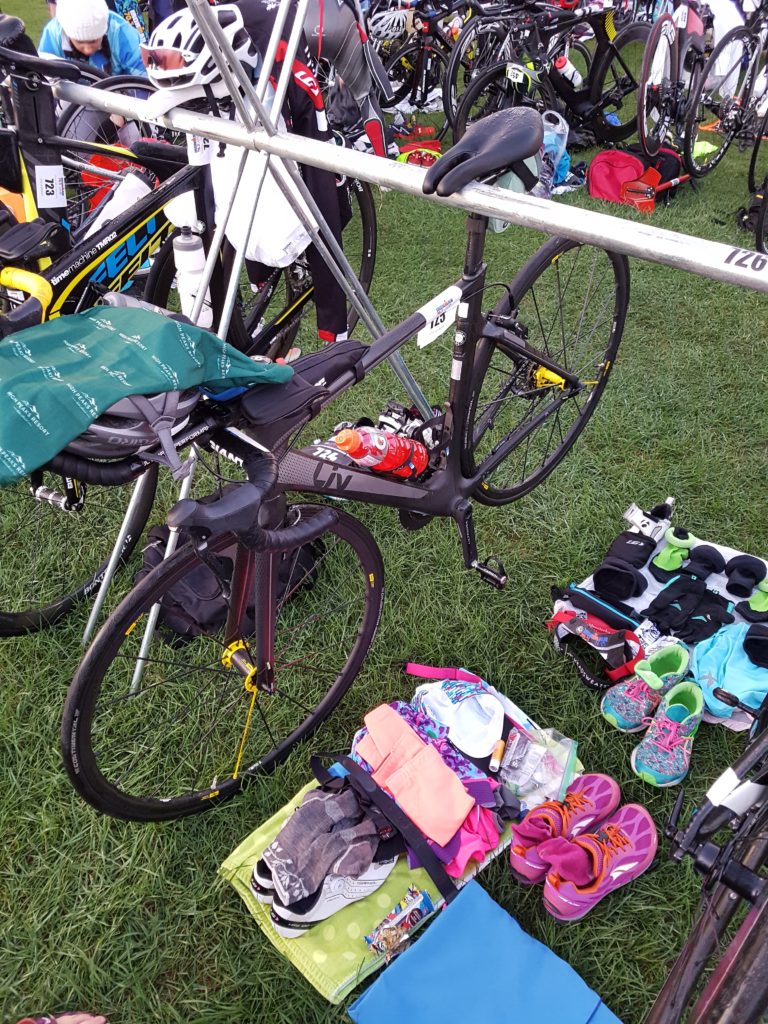

1.2 Mile Swim – 34:28 (01:47/100m)
Division Rank: 12/88, Gender Rank: 64/615
Lauren and I sauntered down to Mirror Lake, shivering as we zipped our wetsuits up. I spotted Rod momentarily, then he abruptly disappeared and not to be seen until the run (he was apparently seeking shelter in the warming tent). I waded into the overly crowded warm-up area – it was so cold that athletes were congregating in the water to warm up! Although we had been warned during Saturday’s pre-race briefing that athletes who urinate in the lake risk a DQ, I have no doubt that the entire cordoned off lake area was full of caffeine-rich urine. After attempting my swim warm-up, I quit after 4 minutes because it was too congested. The swim was a rolling start, which meant athletes were able to self-seed themselves based on their expected finish time. I jogged on the spot next to a friendly man holding the “33-35 MINUTES” sign.
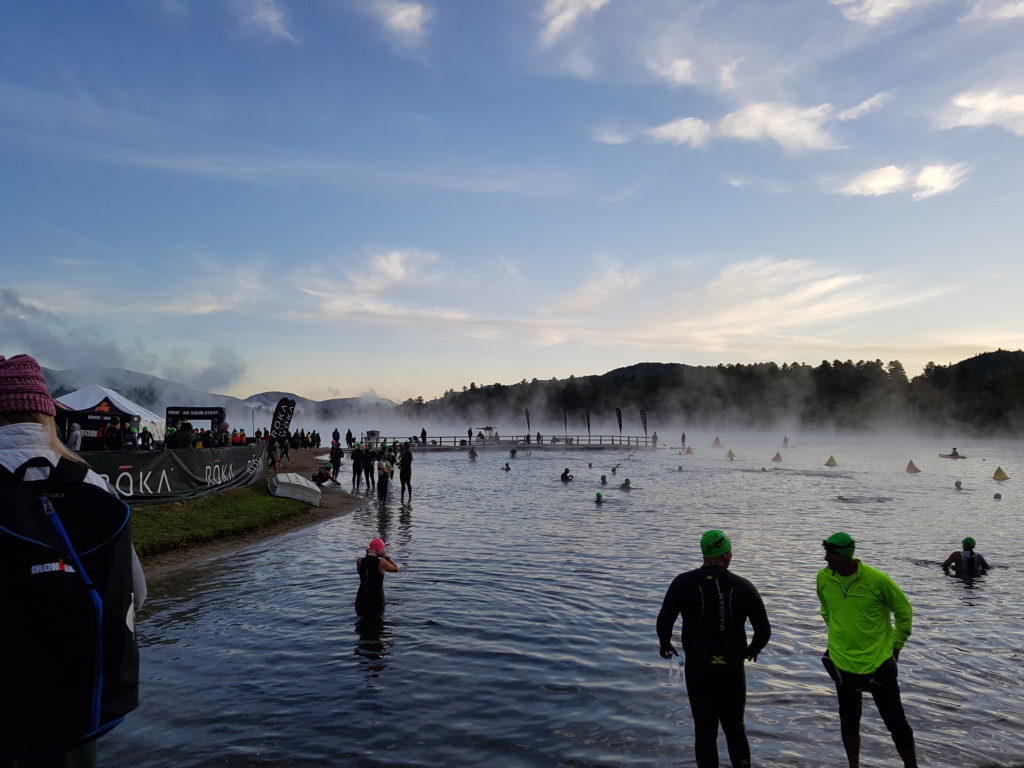
The announcer enlightened us with the exciting news that today was a record-breaking day – it was the coldest start to an Ironman 70.3 in history, with an air temperature of 33°F (0.5°C). After a beautiful rendition of the American national anthem, the gun went off and the fastest swimmers sprinted off the beach into the lake. Before I knew it, it was my turn to run into the water and embark on this long day of exercise. As always, the first 50 to 100 metres were a bit chaotic but everyone spread out and I found my way to the underwater cable, reducing my need to sight. Although the lake had been perfectly calm before we started, the hundreds of swimmers created a chop in the water and caused the cable to oscillate underwater. It was the most relaxed yet strong I have ever felt during the swim portion of a race, which I attributed to an increased swimming volume since August. As Cindy had advised, I minimized my kicking and focused on maintaining a solid catch and pull with every stroke. After passing a few buoys, I could see the sun beginning to rise over the large trees and little did I know I was the warmest I would feel all day long. Throughout the entire swim, I maintained a consistent stroke rate and felt confident overtaking several swimmers. As the swim exit came into sight and I passed the large public dock, I gently increased my kick to prepare my legs for what lay ahead.
Upon exiting the water at the south end of Mirror Lake by the tennis courts, I checked my Garmin watch and was slightly disappointed that I hadn’t swam any faster. I ran right past the wetsuit strippers, eagerly awaiting those brave souls who valued miniscule gains on their T1 over the associated premature loss of body heat. As I sauntered up the blue carpet path towards transition, I finally unzipped my wetsuit and quickly removed it when I arrived at my bike. I paused in awe for a nanosecond when I realized there was literally steam evaporating from my wetsuit because the air temperature was still 0°C. Cindy had asked me to wear my heart rate monitor during the ride and run, so I awkwardly shoved it underneath my sports bra while wearing my one-piece tri suit. I realized I had to remove my watch to don my arm sleeves, which were next to impossible to pull on while wet (obviously I had never rehearsed this during training). The competitive part of me prioritized aerodynamics over comfort and I zipped up my tight-fitting bike jersey rather than cycling jacket, but I later thanked myself for grabbing the Buff to wear as a hat under my helmet. After shoving a granola bar in my mouth and after my longest-ever T1 of 5:59, I hopped on my bike.
56 Mile Bike – 2:52:49 (19.44 mph or 31.29 km/h)
Division Rank: 5/88, Gender Rank: 13/615
Average HR: 152 (min 97, max 166)
Absolute average power: 186 W
Relative average power: 3.04 W/kg
Elevation gain: 920 metres
Temperature: 0 to 10°C
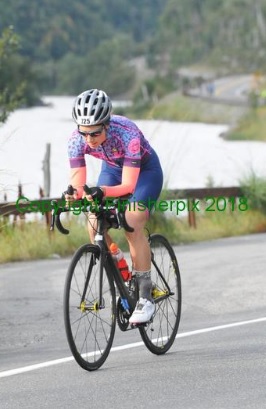
Although I was a bit chilled as I descended the first 4 km down Route 73 and past the infamous Olympic ski jump, I reminded myself that it would only get warmer as the day went on. My quads warmed up quickly as I rode past a few athletes on the small climbs between kilometres 4 and 15, slightly exceeding my coach’s recommended upper power output of 205 W. I silently thanked Rod for suggesting that we scope out the 3-km Olympic Sports Complex out-and-back when we were in Lake Placid this past June, as I was prepared for the short climb leading up to the turnaround and the sharp 90-degree turn on Bob Run Road. It wasn’t until this turnaround at 12.3 km when I passed the first female I had encountered on the bike course, that I realized I was surrounded almost exclusively by male triathletes. I held myself back from riding too aggressively, as I was aware of the pending climb from Wilmington to Lake Placid near the back end of the course, as well as the subsequent half marathon that I had to run.
Descending from North Elba towards Keene, I was conscious of the northeast headwind that curtailed my speed – however, I still did reach 69.8 km/h according to Training Peaks. During the 10 km descent, riding into the headwind enabled me to feel more comfortable in my aerobars than I had on previous training rides because I couldn’t achieve the same maximum speed. I must have been going at a decent clip when I arrived in Keene at kilometre 26 and turned left onto Route 9N, because I don’t recall seeing the Ironman warming tent serving chicken broth on the side of the road.
My toes and fingers were numb as I hammered the 14 km gradual downhill segment between Keene and Jay and I constantly wiggled them to increase circulation. Rod later described that it felt like he had “rocks in his cleats” because his toes were so numb. As it was roughly 9 am, it was still quite cold (2 to 4°C) and the trees were casting shadows on the road, preventing the sun from reaching us. Strava later told me that I PR’d this segment: speed 36.4 km/h, power output 195 W, heart rate 148. A 90-degree left turn onto Route 86 at kilometre 41 marked the beginning of a 2.4 km steady climb at a 4% grade. Thanks to a now-tailwind and in an effort to warm up my extremities, I PR’d this segment as well. A hundred metres in, I spotted a male athlete crouched over on someone’s driveway desperately attempting to change his tube; a local man had kindly placed a blanket around the athlete’s shoulders to keep him warm. As I spun past a group of athletes, Adam from Chattanooga yelled out, “Go, Lisa!” and I replied with encouraging words for him.
At kilometre 46.5, the bike course turned right onto Bilhuber Road and then danced along the West Branch of the Ausable River on Hazelton Road. Memories of the hot, sweaty ride with Bob from Long Island flooded back to me. Bob was a super friendly man in his late 50s who was training for the full Ironman Lake Placid when Rod and I caught up to him on a ride in late June; we spontaneously rode together at a pretty good clip along the entire bike course and had very pleasant conversation for 3 hours. After the Hazelton turnaround (which was sooner than expected), I shook my head in disbelief as a 20-person peloton blew by on the opposite side of the road – so much for respecting the no-drafting policy! I exchanged my own Gatorade bottle for a Gatorade Endurance bottle at the 64-km mark and boy, that Endurance formula sure is tasty! Apparently it has twice the amount of sodium and potassium as the original Gatorade, but the same amount of carbohydrates.
The dreaded long ascent from Wilmington to Lake Placid didn’t feel quite as awful as I had anticipated, likely due to the wind giving us a gentle push from behind. At kilometre 71, I was horrified to realize that we had to complete a strenuous out-and-back section at Whiteface Mountain Ski Area, which concluded with a punishing 9% climb back onto Route 86. I forced myself to continue fueling during the remainder of the ride and finally began to feel tiny beads of perspiration on my face and chest as I raced up the Three Bears climb, spray painted on the road for those not familiar with the popular Strava segment. It was exhilarating to return back to Lake Placid, with people cheering loudly next to the barriers and having to negotiate a few hairpin turns before re-entering transition.
Bike Nutrition:
1.5 x 710 mL bottles of Gatorade
3.5 x Quaker chocolate chip granola bars
1 x GU Roctane blueberry pomegranate gel
My T2 (3:23) was much faster than T1, as I removed my Buff, bike jersey and arm sleeves, changed my socks/shoes and snatched my Garmin watch, race belt and Ziploc bag containing 6 shot blocks, a Tums and a gel. I made a quick porta-potty stop to empty my full bladder – stupid cold diuresis phenomenon – and was on my way.
13.1 Mile Run – 1:41:50 (7:46/mi or 4:47/km)
Division Rank: 5/88, Gender Rank: 12/615
Average HR: 163 (min 144, max 176)
Elevation gain: 156 metres
My legs felt surprisingly fresh as I dashed down Main Street and back onto Route 73, which resulted in a speedy first kilometre split of 4:24. My race plan was to run the first 4 km at 4:45/km and then hold onto that pace as long as I could, and if I wanted to accelerate, I would have to hold that faster pace for the entire race. Reality set in as the course gently ascended from kilometre 1 to 3.2 and my pace briefly slowed to 5:00/km. As I accelerated down the hill and turned left onto Riverside Drive just before 4 km, I spotted the male in first place rounding the corner towards me and heading back up towards Lake Placid. I thought to myself, yes! Lots of fast athletes to watch and help pass the time! The rolling hills and picturesque, winding road resulted in the mile markers going by faster than I expected. I distracted myself by counting down the number of women ahead of me – I was pleased to calculate that I was 12th or 13th from the front. I spotted Rod heading back towards town within 1 km of the Riverside turnaround and based on our current running fitness, I knew I would likely catch him. I must have been way too in the zone because he later told me that I pushed him aside at one of the aid stations, yelling, “Water! Water!” In my defense, I have absolutely no recollection of this incident and triathlon is a strictly non-contact sport (apart from accidental collisions during the swim). During the remainder of the race, I kept scanning my competitors ahead and was confused when I later saw him running towards the Mirror Lake turnaround when I was about 1 km from the finish line.
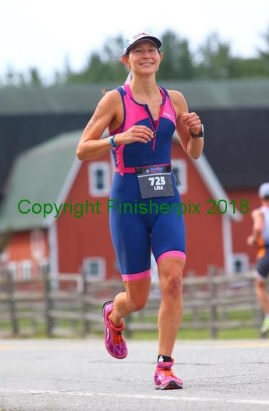
I managed to maintain my goal 4:45/km pace for the majority of the run, slowing down considerably for the two sizable hills: the first one from 14.2 to 15.7 km from Riverside Drive towards the ski jump, and the final, seemingly never-ending mountain leading back into town from 17.6 to 19.6 km. As I finished the final 2 km climb onto Mirror Lake Drive, enthusiastic spectators wearing down jackets cheered me on by my name and I felt a surge of energy return to my legs. I was optimistic that the Mirror Lake out-and-back was short and sweet, but in actual fact it was 3 grueling kilometres. The number of spectators quickly diminished the further I ran from Main Street and I began to feel isolated, along with an alarming tightening of my right quads. It took a lot of effort to unwrap, but I managed to shove a chewy Tums in my mouth to ward off muscle cramping – and it worked! Eventually, the course looped back shortly before Northwood Road, and I was passed by many triathletes finishing up the bike portion of the race and heading back into transition. As I approached the Olympic oval, I subtly turned around to check my competition and was relieved that there was no one trailing close behind. I turned my legs over as fast as I could to finish strong down the red carpet and crossed the finish line with a run of 1:41:50 – my fastest ever half marathon time.
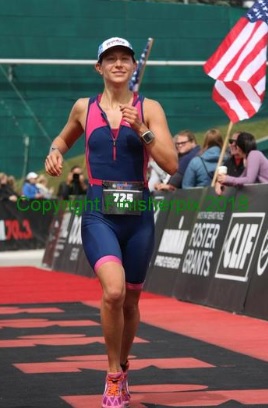
Run Nutrition:
Sips of water
6 black cherry Clif Shot Blocks
1 chewy Tums
Post Race
A kind volunteer congratulated me and gently guided me through the finish area. I readily wrapped the thermal blanket around myself to conserve as much body heat as possible. While waiting for Rod, the endorphin-high social butterfly in me emerged. I recognized and approached the woman who had come in 1st place at Muskoka 70.3 and we chatted for a couple minutes – I later found out she had come in 2nd place in our age group! I spoke with a few guys who I had kept pace with on the bike and/or run, and congratulated them on their races. I only had to wait a few minutes for Rod to cross the finish line so we could get our requisite post-race photo together. We refuelled with mac & cheese, delicious pizza, pretzels and fruit for a solid 30 minutes, then hung around and waited by the finish line to cheer for Lauren!
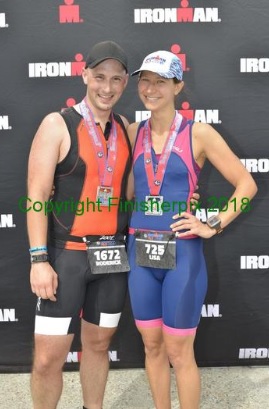
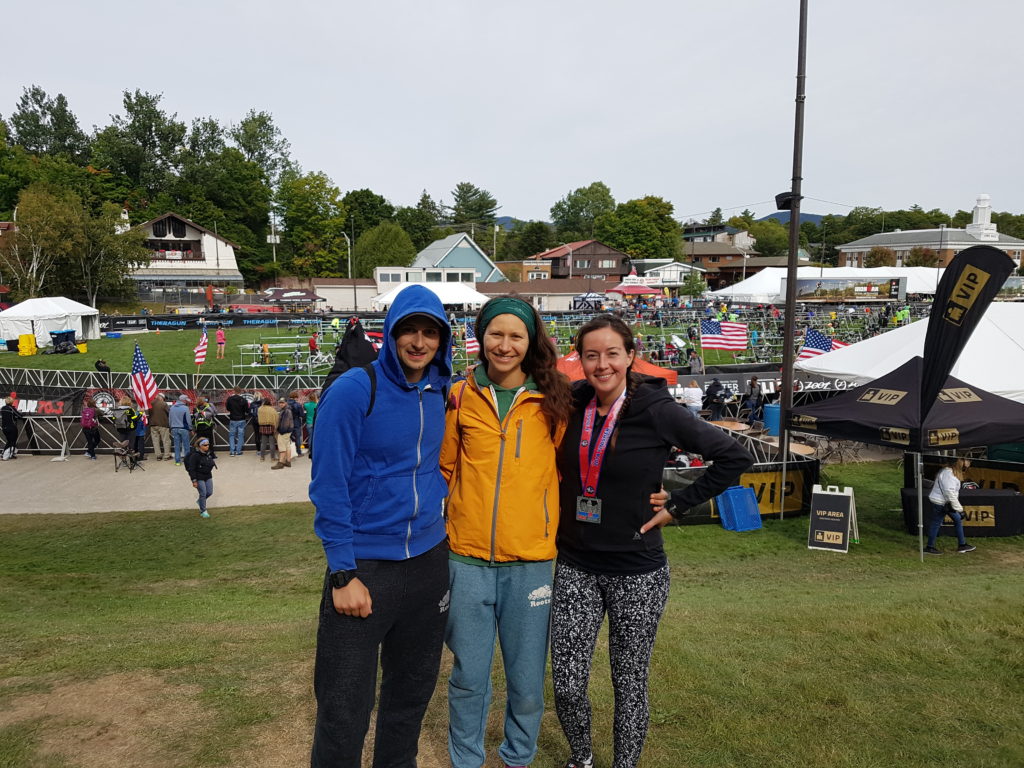
I was thrilled to find out that I had finished 5th in my age group and 12th female overall, with an official time of 5:18:29! Rod kindly waited around with me for the awards ceremony and I received my M-dot plaque on stage.
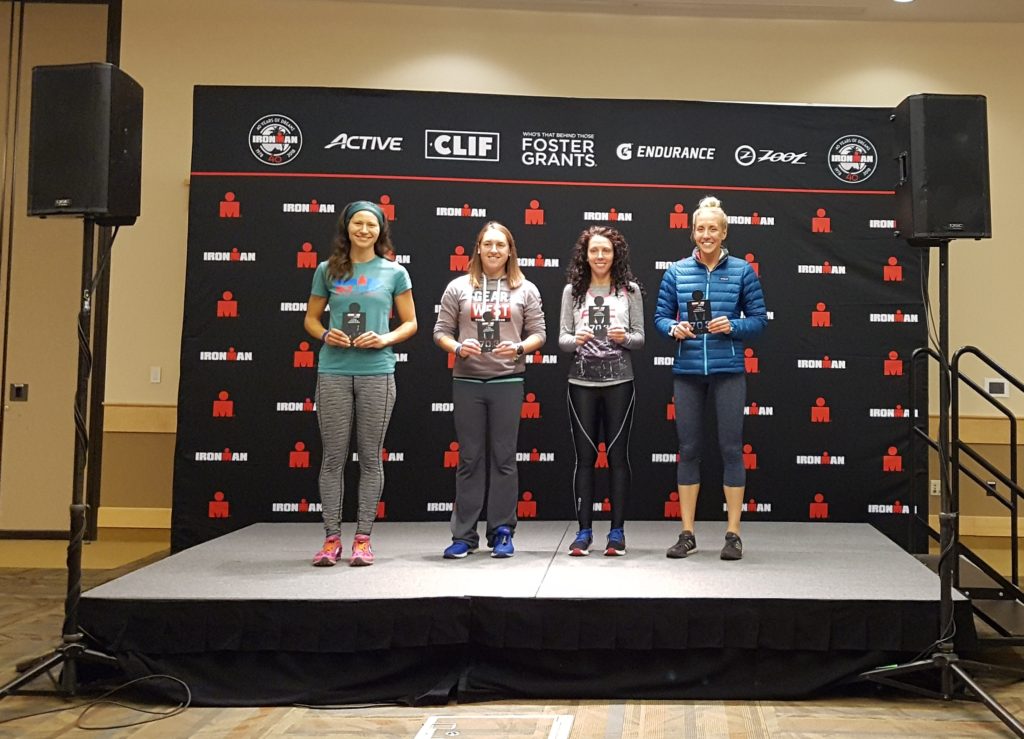
Lauren and Alex stayed in Lake Placid for the next 2 days, and we hit the major tourist spots – driving up Whiteface Mountain (we had only ever biked up!), exploring the bear souvenir shops, the Olympic ice rink and the Olympic museum – all of which I highly recommend going to see. Rod and I spent the remainder of the week in town with low-volume recovery swimming and cycling, and I managed to convince him to join me for 3 scenic hikes – Connery & Owen Ponds, Indian Head/Fish Cliffs/Rainbow Falls and Cascade Mountain/Porter Mountain. We decided to save the Trap Dyke for another trip.
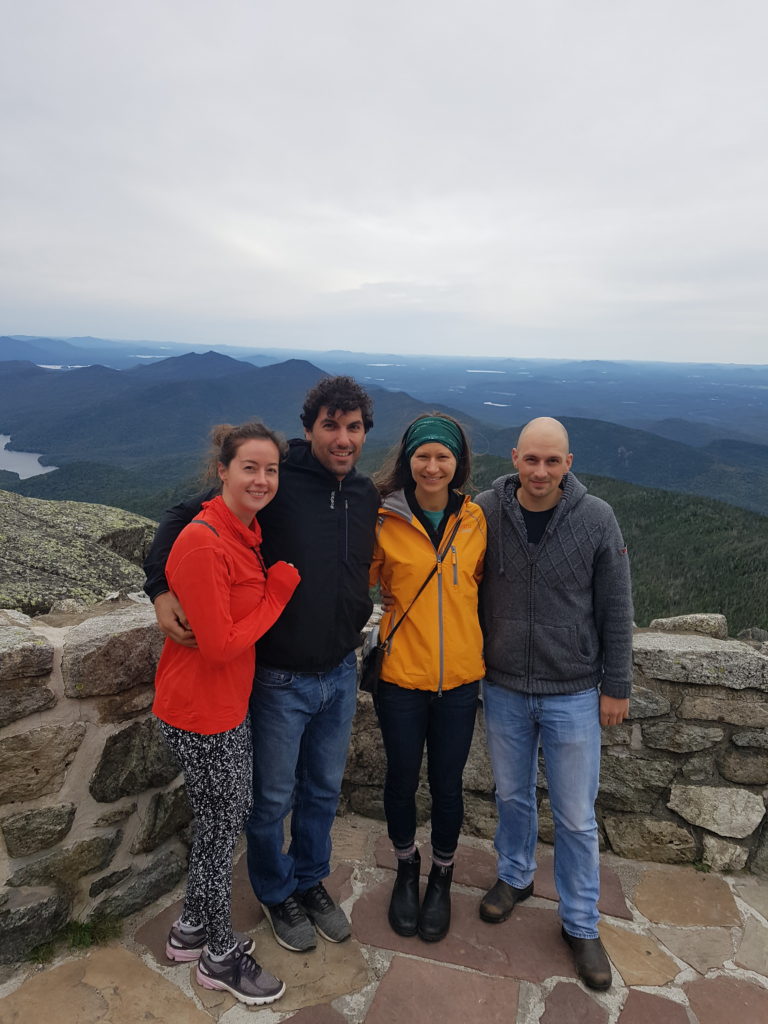
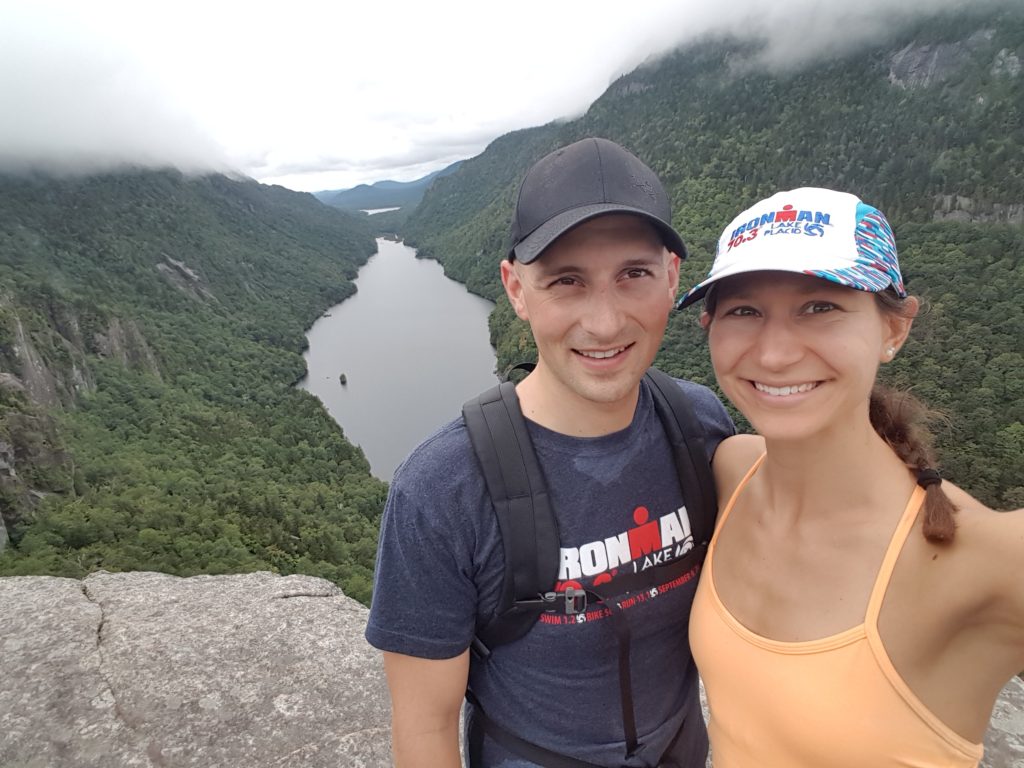
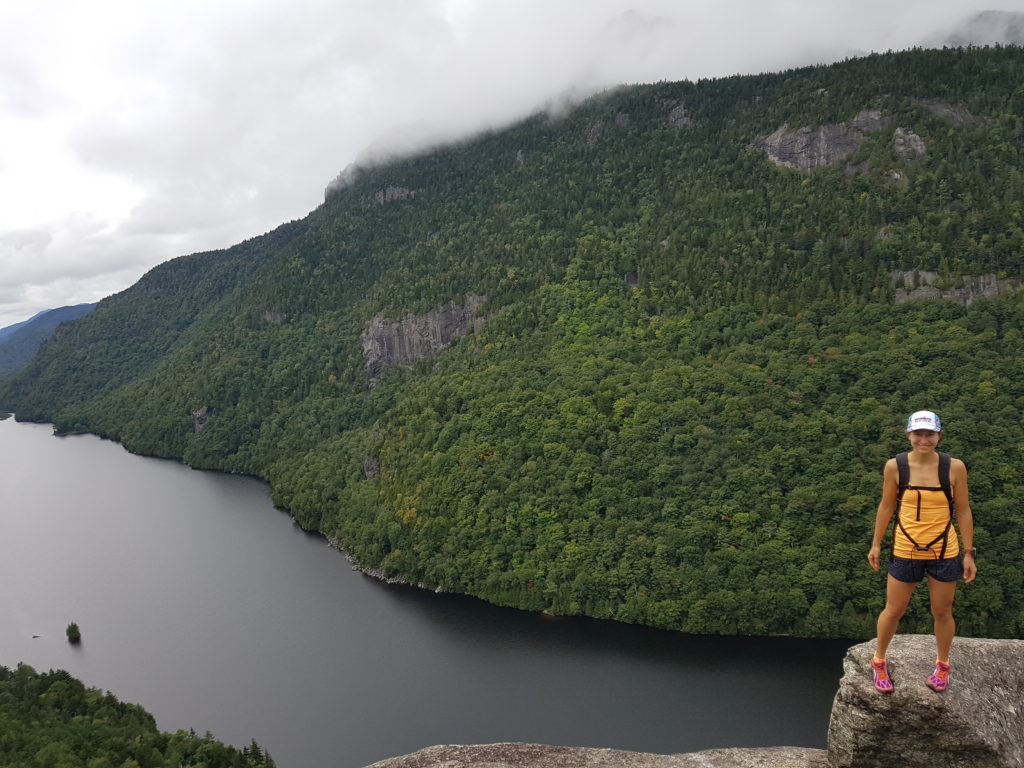
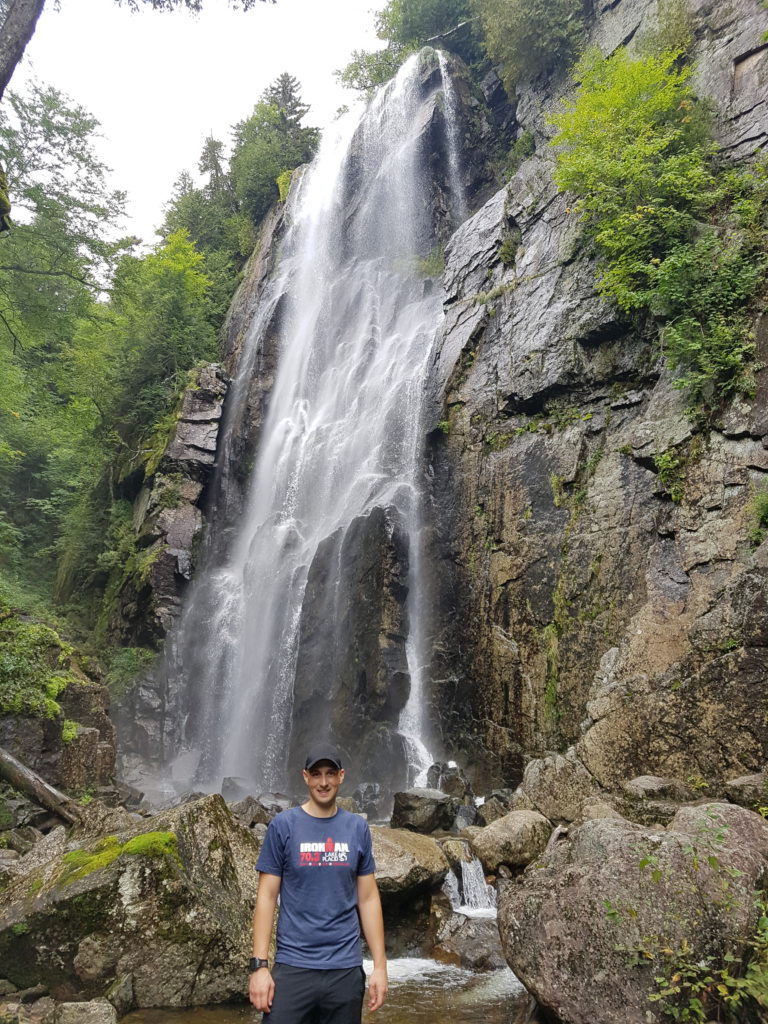
Reflection
I am my own toughest critic and often focus on where I can improve, rather than celebrate my successes. In a phone conversation with my coach a week after the race, she praised me for making some smart decisions on race morning. Namely, I stayed as warm as possible until the swim start and I took extra time in transition to dress appropriately for the ride. I think my performance is the result of a few important factors: improved work/life balance with more time available to train and recover (I’ve been working part-time hours since July), structured workouts and immediate feedback from a skilled coach, and increased training volume over the 6 weeks preceding the race.
As this was my final triathlon of 2018, I’m excited to continue working with my coach over the winter to prepare for my 2019 season, including at least one 70.3 distance race, Ironman Canada in July and the ITU World Triathlon Grand Final in Lausanne, Switzerland!
Thanks for reading and please follow me on Strava and Instagram!
